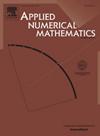Combined high order compact schemes for non-self-adjoint nonlinear Schrödinger equations
IF 2.2
2区 数学
Q1 MATHEMATICS, APPLIED
引用次数: 0
Abstract
Some combined high order compact (CHOC) schemes are proposed for non-self-adjoint and nonlinear Schrödinger equation (NSANLSE). There are first order and second order spatial derivatives , in the NSANLSE. If one uses classical high order compact schemes to approximate and separately, it will widen the bandwidth in practical coding due to matrix multiplication. This will partly counteract the advantages of high order compact. To overcome the deficiency, one solves the spatial derivatives simultaneously by combining them. In other words, it solves and simultaneously in terms of . The idea is applied to discretize NSANLSE in space. Two efficient numerical schemes are proposed for NSANLSE. The stability and convergence of the new schemes are analyzed theoretically. Numerical experiments are reported to verify the new schemes.
求助全文
约1分钟内获得全文
求助全文
来源期刊

Applied Numerical Mathematics
数学-应用数学
CiteScore
5.60
自引率
7.10%
发文量
225
审稿时长
7.2 months
期刊介绍:
The purpose of the journal is to provide a forum for the publication of high quality research and tutorial papers in computational mathematics. In addition to the traditional issues and problems in numerical analysis, the journal also publishes papers describing relevant applications in such fields as physics, fluid dynamics, engineering and other branches of applied science with a computational mathematics component. The journal strives to be flexible in the type of papers it publishes and their format. Equally desirable are:
(i) Full papers, which should be complete and relatively self-contained original contributions with an introduction that can be understood by the broad computational mathematics community. Both rigorous and heuristic styles are acceptable. Of particular interest are papers about new areas of research, in which other than strictly mathematical arguments may be important in establishing a basis for further developments.
(ii) Tutorial review papers, covering some of the important issues in Numerical Mathematics, Scientific Computing and their Applications. The journal will occasionally publish contributions which are larger than the usual format for regular papers.
(iii) Short notes, which present specific new results and techniques in a brief communication.
 求助内容:
求助内容: 应助结果提醒方式:
应助结果提醒方式:


